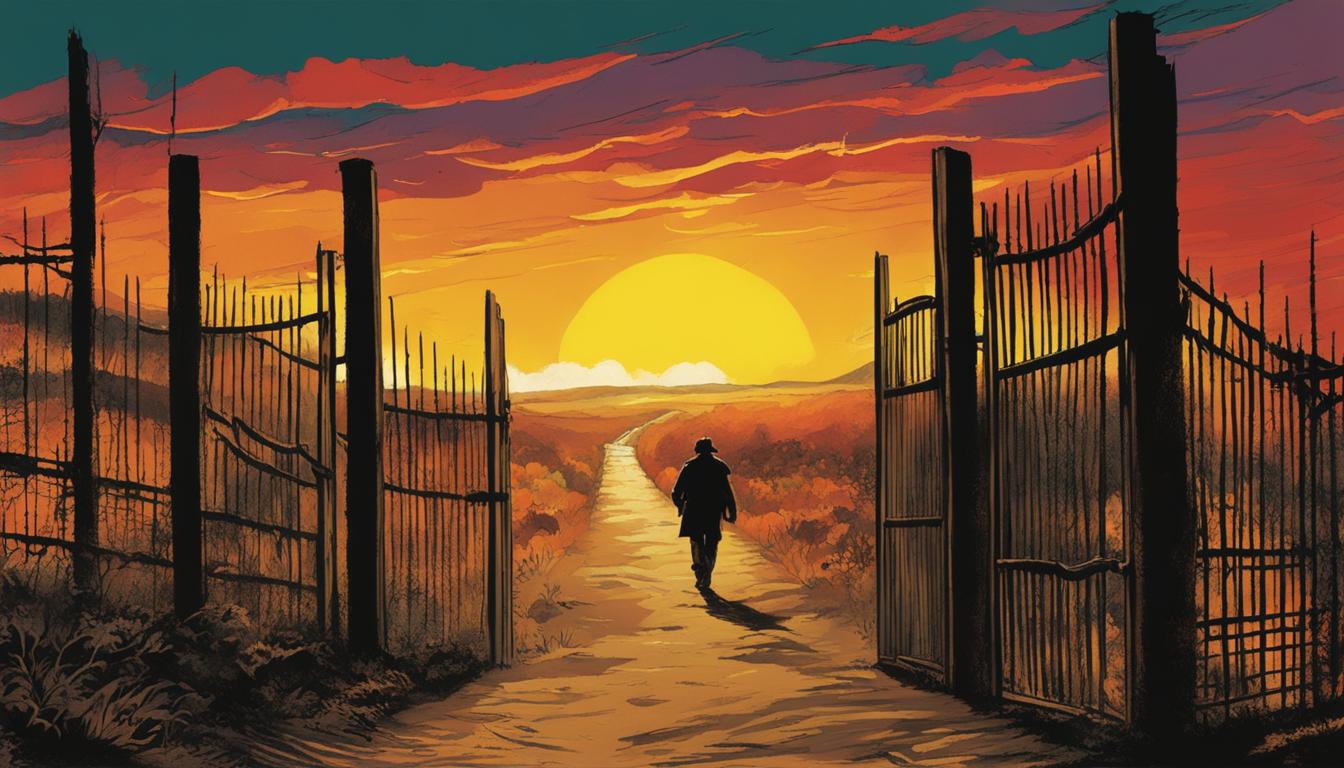Border Crossing, written by acclaimed author Pat Barker, is a literary thriller that explores complex moral questions and psychological depths of the human mind. Set in the present time, the book follows the story of Tom Seymour, a psychiatrist who is now retired, as he comes face to face with a former patient, Danny Miller, whom he had treated when he was 10 years old. The encounter forces Tom to confront his moral decisions and their consequences.
Barker’s writing style is captivating, providing vivid descriptions of characters, settings, and situations. Her talent for psychological analysis makes the novel gripping and thought-provoking at the same time.
Key Takeaways
- Border Crossing is a literary thriller that explores morality and psychology, written by Pat Barker.
- The novel follows a retired psychiatrist, Tom Seymour, as he confronts a former patient, Danny Miller.
- Barker’s writing style is vivid and thought-provoking, making the novel a gripping read.
- The novel forces readers to confront complex moral dilemmas and delve into the depths of human psychology.
- The character development and exploration of moral themes make Border Crossing a must-read for fans of literary fiction.
About the Author – Pat Barker
Pat Barker is an English writer born in Thornaby-on-Tees in 1943. She attended the London School of Economics, where she studied International History, and later went on to pursue a successful writing career. Barker is known for her captivating works of fiction that explore themes of memory, trauma, and the human condition.
One of her most renowned works, the Regeneration Trilogy, which includes the novels Regeneration, The Eye in the Door, and The Ghost Road, is set during World War I and explores the psychological effects of war on soldiers. The trilogy won numerous awards, including the prestigious Booker Prize, and helped cement Barker’s reputation as one of the most significant voices in contemporary literature.
Barker has received many accolades throughout her career, including the Commander of the Order of the British Empire (CBE) in 2000 and the Guardian Fiction Prize for her novel Another World in 1998.
Introduction to Border Crossing
Border Crossing is a powerful novel written by the renowned author, Pat Barker. The book tells the story of two characters, Danny Miller and Tom Seymour, whose lives become intertwined after a traumatic event in their youth. The novel explores themes of guilt, morality, and redemption, set against the backdrop of the English countryside and the Scottish borders. Throughout the story, Barker deftly weaves together powerful psychological insights with gripping narrative tension that will keep readers on the edge of their seats.
“Pat Barker’s writing is at its best in Border Crossing… This is a bold book that packs a punch and will keep you turning the pages until the end.” -The Guardian
Plot Summary
In Border Crossing, we follow the story of two individuals, Danny Miller and Tom Seymour, who are reunited 15 years after Danny was sent to a juvenile detention center for murdering a young girl. Danny, now a psychiatrist, meets Tom by chance at a border crossing and becomes convinced that Tom is hiding a dangerous secret.
As Danny tries to uncover the truth about Tom, he is forced to confront his own internal conflicts and morality. Meanwhile, Tom’s own dark past is slowly revealed, leading to a dramatic climax that will leave readers on the edge of their seats.
“I don’t know why…I don’t know why I did it. I just saw her…it was like she was calling to me.” – Danny Miller
Main Characters
Border Crossing is a novel that revolves around the lives of two main characters, Tom Seymour and Danny Miller. Tom is a retired psychologist, while Danny is a convicted murderer who was once under Tom’s care as a child. The two meet years later, and their paths cross once again, leading to unexpected consequences.
Tom Seymour is a complex character who grapples with an array of emotions and internal conflicts. As a retired psychologist, Tom has spent his life delving into the minds of others, trying to make sense of their troubled pasts. Throughout the novel, we see Tom struggling to come to terms with his past and the guilt he carries from a case gone wrong.
Danny Miller, on the other hand, is a character who is shrouded in mystery. He is a convicted murderer who has just been released from prison after serving his sentence. We see Danny struggling to fit back into society and establish relationships. His past haunts him, and he grapples with the guilt and shame of his actions.

“I was doing something for which there could be no forgiveness. It was the kind of mistake that could never be put right, except by the passage of time.”
The supporting cast of characters is also integral to the story, providing insight into the lives of Tom and Danny. Stella, Tom’s wife, is a character who tries to keep her husband grounded while dealing with her challenges. Liam, Danny’s brother, is a character who tries to help his brother and protect him from further harm.
The nuanced portrayal of the characters adds depth and complexity to the novel, making it a compelling read that delves into the human psyche.
Moral Dilemmas Explored
In Border Crossing, Pat Barker delves into complex moral dilemmas that span a lifetime. The novel raises questions about the nature of guilt and responsibility, and asks whether individuals can ever truly be held accountable for their actions.
Through the story’s protagonist, psychologist Tom Seymour, the reader is confronted with the moral dilemma of whether to disclose information about a crime committed by his patient, Danny Miller. This decision haunts Seymour for years, leading him down a path of self-reflection and discovery.
As Seymour grapples with his own sense of morality, the reader is forced to consider their own ethical code. The novel challenges us to examine our beliefs about right and wrong, and to contemplate the consequences of our actions.
“What is moral is what you feel good after and what is immoral is what you feel bad after.” – Ernest Hemingway
Border Crossing raises powerful questions that have relevance far beyond the story itself. What is the responsibility of individuals in the face of evil? And can justice ever truly be served? These moral dilemmas are at the heart of this gripping novel.
Psychological Depths
Border Crossing’s intense portrayal of moral dilemmas is mirrored by the psychological depths it depicts in the characters’ minds. Throughout the novel, Pat Barker crafts multidimensional characters who grapple with their conscience and deepest fears.
The protagonist, Tom, struggles with guilt and shame from a childhood accident that haunts him into adulthood. His obsession with a new case involving a possible murder reflects his need for redemption and self-forgiveness. Furthermore, the antagonist, Danny, displays a complex range of emotions, hinting at deeper psychological issues and emotional scars.
“He can see how Waring’s hands would bunch up on the steering wheel, how his breath would go high in his chest, how his thoughts would start clotting, tumbling over each other, until he either couldn’t think at all or thought of the wrong questions and the wrong answers”
Through Barker’s skilled use of internal monologue and subtle language, she allows readers to glimpse into the characters’ minds, unveiling layers of psychological depth and complexity.
Writing Style and Themes
Pat Barker’s writing style in Border Crossing is characterized by its directness and emotional intensity. Her prose is spare and simple, yet manages to evoke complex psychological states with precision and insight. Barker is a master at using detail to create atmosphere, and she employs a range of literary techniques to convey the characters’ inner worlds.
One of the prominent themes in Border Crossing is the nature of morality, as it relates to crime and punishment. Barker explores the complex and ambiguous relationship between guilt, responsibility, and justice, and challenges the reader to reflect on their own beliefs and assumptions about these issues. Another key theme in the novel is the fluid and unstable nature of personal identity. The characters are constantly grappling with questions of who they are and who they want to be, as they move through different stages of life and encounter new challenges and obstacles.
“It’s like you have two selves, isn’t it? A real self and a shadow self, and the second one follows you wherever you go.”
Barker’s writing style and themes are finely interwoven, creating a deeply affecting and thought-provoking work of literary fiction. Her ability to convey complex emotions and ideas with clarity and immediacy makes Border Crossing a powerful and insightful read.
Critical Reception
Border Crossing has received largely positive critical reception since its publication in 2001. Reviewers have applauded Pat Barker’s masterful exploration of morality and psychology, as well as her gripping writing style. The novel has been described as haunting, intense, and thought-provoking.
Some notable reviews of Border Crossing include:
| Publication | Review Excerpt |
|---|---|
| The New York Times | “Border Crossing is a tense, vividly written novel of ideas that is also a suspenseful thriller. Barker captures the psychological complexities of her characters with subtlety and skill.” |
| The Guardian | “This is writing of great power, and the reader is swept along with the force of Barker’s prose. It’s a novel that lingers in the memory long after the last page.” |
| The Independent | “Border Crossing is an astonishing achievement, a heart-stopping meditation on alienation, guilt, and the mysteries of the human psyche. Barker is a writer of rare grace and insight.” |
Overall, Border Crossing has been widely praised for its psychological depth, moral complexity, and masterful writing. The novel remains a captivating and relevant read more than twenty years after its initial publication.

Impact and Legacy
Border Crossing has made a significant impact on literature since its publication. The novel’s exploration of complex moral dilemmas and psychological depths of the characters has left a lasting impression on readers. Pat Barker’s writing style and themes have influenced many writers after her.
Border Crossing remains a significant work within Barker’s body of work, showcasing her abilities as a writer and storyteller. The novel has garnered critical acclaim and numerous awards, cementing its place within the literary canon.
Border Crossing’s legacy has extended beyond literature, with a film adaptation in development. The story’s themes and characters have resonated with audiences, expanding its impact beyond the written page.
Film Adaptation
Border Crossing, the acclaimed novel by Pat Barker, has yet to be adapted into a film.
Although no movie adaptation of the book exists, there have been rumors circulating about potential film projects based on the novel. However, as of now, there is no official information on any forthcoming adaptations.
Despite the lack of a film adaptation, Border Crossing has had a significant impact in the literary world, receiving critical acclaim for its thought-provoking exploration of morality and its gripping psychological depth.
“I would love to see Border Crossing adapted into a film. The novel presents such a powerful and emotional story, and I believe it could translate into an incredible cinematic experience.” – Pat Barker
Similar Books by Pat Barker
If you enjoyed reading Border Crossing by Pat Barker, we recommend the following similar books:
| Book Title | Genre | Synopsis |
|---|---|---|
| The Silence of the Girls | Historical Fiction | In this reimagining of the Trojan War, Barker offers the perspective of Briseis, a slave and spoils of war. As she navigates life in the Greek camp, she offers a unique vision of the epic conflict and its aftermath. |
| Regeneration | Historical Fiction | This novel follows the poet Siegfried Sassoon as he undergoes treatment for shell shock during World War I. Set in a psychiatric hospital, the personal relationships between patients and staff form a probing exploration of human nature and the psychological wounds of war. |
| The Ghost Road | Historical Fiction | The final installment of Barker’s Regeneration trilogy, this novel follows Lt. Billy Prior as he returns to the frontlines of World War I. As he grapples with his experiences of trauma and violence, he confronts the ultimate question of what it means to be a soldier. |
These books by Pat Barker explore similar themes of morality, psychology, and personal struggle. Each one offers a profound and thought-provoking examination of the human spirit, making them excellent choices for readers who enjoyed Border Crossing.
Conclusion
In conclusion, Border Crossing by Pat Barker is a gripping novel that explores complex moral dilemmas and psychological depths. The plot summary and analysis of the main characters demonstrate the exceptional writing style and the themes explored throughout the book. Pat Barker’s work has received critical acclaim, and Border Crossing is no exception, with its lasting impact on literature. As a book recommendation, if you enjoyed Border Crossing, we further recommend checking out other works by Pat Barker, such as The Silence of the Girls and Toby’s Room.
FAQ
Is Border Crossing a standalone novel or part of a series?
Border Crossing is a standalone novel written by Pat Barker. It is not part of a series.
Could you provide a brief summary of Border Crossing?
Border Crossing by Pat Barker tells the gripping story of a psychologist named Tom Seymour who is haunted by a past case involving a young boy who committed a chilling crime. When the boy resurfaces as an adult, seeking a pardon, Tom is faced with a moral dilemma and must confront his own troubled past.
What is the writing style of Border Crossing?
Pat Barker’s writing style in Border Crossing is engaging and thought-provoking. She skillfully tackles complex moral themes with precision and delivers powerful descriptions of the characters’ psychological depths.
Who are the main characters in Border Crossing?
The main characters in Border Crossing include Dr. Tom Seymour, a psychologist haunted by his past; Danny Miller, the young boy who committed a crime; and Lauren Seymour, Tom’s wife who supports him through the challenges he faces.
Are there any film adaptations of Border Crossing?
As of now, there are no notable film adaptations of Border Crossing.
What are some similar books written by Pat Barker?
If you enjoyed Border Crossing, you may also enjoy other books by Pat Barker such as Regeneration, The Ghost Road, and The Silence of the Girls. These novels explore similar themes of morality, psychological depth, and the complexities of human nature.



